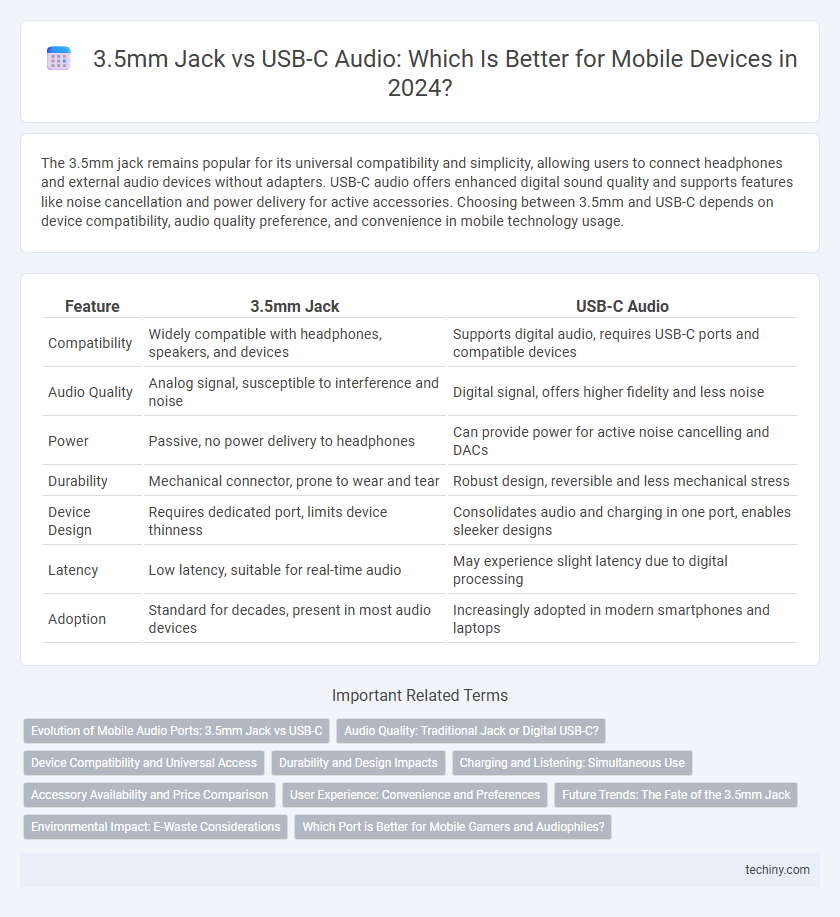The 3.5mm jack remains popular for its universal compatibility and simplicity, allowing users to connect headphones and external audio devices without adapters. USB-C audio offers enhanced digital sound quality and supports features like noise cancellation and power delivery for active accessories. Choosing between 3.5mm and USB-C depends on device compatibility, audio quality preference, and convenience in mobile technology usage.
Table of Comparison
| Feature | 3.5mm Jack | USB-C Audio |
|---|---|---|
| Compatibility | Widely compatible with headphones, speakers, and devices | Supports digital audio, requires USB-C ports and compatible devices |
| Audio Quality | Analog signal, susceptible to interference and noise | Digital signal, offers higher fidelity and less noise |
| Power | Passive, no power delivery to headphones | Can provide power for active noise cancelling and DACs |
| Durability | Mechanical connector, prone to wear and tear | Robust design, reversible and less mechanical stress |
| Device Design | Requires dedicated port, limits device thinness | Consolidates audio and charging in one port, enables sleeker designs |
| Latency | Low latency, suitable for real-time audio | May experience slight latency due to digital processing |
| Adoption | Standard for decades, present in most audio devices | Increasingly adopted in modern smartphones and laptops |
Evolution of Mobile Audio Ports: 3.5mm Jack vs USB-C
The evolution of mobile audio ports has shifted from the ubiquitous 3.5mm jack, known for its universal compatibility and analog sound quality, to the digital versatility of USB-C ports, which support higher resolution audio and multifunctional connectivity. USB-C's integration simplifies device design by combining audio, charging, and data transfer into a single port, enhancing user convenience despite requiring adapters for traditional headphones. This transition reflects broader trends in smartphone technology, emphasizing compactness and enhanced audio performance through digital interfaces over legacy analog connections.
Audio Quality: Traditional Jack or Digital USB-C?
The 3.5mm jack delivers analog audio signals, often praised for its consistent sound quality and compatibility with a wide range of headphones and audio equipment. USB-C audio utilizes digital transmission, enabling advanced features like active noise cancellation and higher-resolution audio formats, but its quality depends on the device's built-in digital-to-analog converter (DAC). Audio quality comparison hinges on DAC implementation and headphone compatibility rather than the connector type alone, with USB-C offering greater flexibility for future audio innovations.
Device Compatibility and Universal Access
The 3.5mm jack maintains widespread device compatibility, supporting a broad range of headphones and audio accessories across smartphones, laptops, and tablets without requiring adapters. USB-C audio offers enhanced functionality with digital sound processing and power delivery, but its compatibility varies among devices and often necessitates conversion accessories for older audio equipment. Universal access remains more consistent with the 3.5mm jack, as USB-C standards are still evolving and fragmenting across manufacturers.
Durability and Design Impacts
The 3.5mm jack offers a robust analog connection with a simple, durable design renowned for resistance to physical wear over time. USB-C audio ports provide a versatile digital interface but often suffer from increased fragility due to smaller, more intricate connectors that are susceptible to damage. Device designs benefit from USB-C's compact form factor, enabling slimmer profiles and multifunctional ports, while 3.5mm jacks require more space and limit aesthetic flexibility.
Charging and Listening: Simultaneous Use
The 3.5mm audio jack enables simultaneous listening and charging without requiring adapters, maintaining consistent audio quality and power delivery. USB-C audio often demands either dongles or dual USB-C ports to support both functions concurrently, which can limit convenience and increase device bulk. However, USB-C can offer higher-resolution audio and faster charging speeds when properly supported by hardware and software integration.
Accessory Availability and Price Comparison
The 3.5mm jack remains widely supported with a vast range of affordable headphones and accessories available on the market, making it a cost-effective choice for many users. USB-C audio accessories tend to be more expensive and less prevalent, as manufacturers focus on a newer, digital audio standard that requires compatible devices and adapters. Consumers should consider the broader accessory ecosystem and price differences when choosing between 3.5mm jack and USB-C audio solutions.
User Experience: Convenience and Preferences
The 3.5mm jack offers broad compatibility with a wide range of headphones, providing users a simple plug-and-play experience without adapters or power requirements. USB-C audio delivers enhanced sound quality and supports active features like noise cancellation, but often demands adapters or specific headphones, which can reduce convenience. User preferences hinge on device ecosystem compatibility and prioritization of audio fidelity versus ease of use and universal support.
Future Trends: The Fate of the 3.5mm Jack
The 3.5mm jack faces a decline as USB-C audio gains traction due to superior audio quality and universal compatibility with modern mobile devices. Industry trends indicate a shift toward wireless and USB-C audio solutions, driven by consumer demand for minimalist designs and enhanced functionality. Despite nostalgia and legacy device support, the 3.5mm jack is increasingly seen as obsolete in future mobile technology landscapes.
Environmental Impact: E-Waste Considerations
The 3.5mm audio jack contributes less to e-waste as it is a standardized, durable analog interface compatible with a wide range of existing headphones, reducing the need for adapters and replacements. USB-C audio relies on digital components and often requires additional accessories such as DACs or adapters, which can lead to increased electronic waste when devices or cables become obsolete. Transitioning to USB-C may result in higher e-waste accumulation due to faster device turnover and the proliferation of proprietary dongles, impacting environmental sustainability in the mobile technology sector.
Which Port is Better for Mobile Gamers and Audiophiles?
The 3.5mm jack offers universal compatibility and zero-latency audio, making it ideal for mobile gamers who need precise sound cues in real-time. USB-C audio provides higher power output and supports advanced audio processing, benefiting audiophiles seeking superior sound quality and noise cancellation. While USB-C enables digital audio formats, the 3.5mm jack remains preferred for low-latency and broad accessory support in competitive mobile gaming scenarios.
3.5mm Jack vs USB-C Audio Infographic

 techiny.com
techiny.com